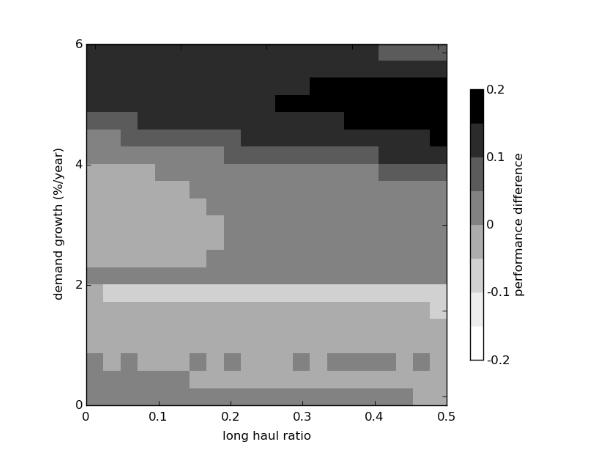
J.H. Kwakkel, W.E. Walker, and V.A.W.J. Marchau
This paper is available online at Environment and Planning B
Link: http://www.envplan.com/abstract.cgi?id=b37151
This paper assesses the efficacy of a Dynamic Adaptive Planning (DAP) approach for guiding the long-term development of infrastructure. The efficacy of the approach is tested on the specific case of airport strategic planning. Utilizing a fast and simple model of an airport, and a composition of small models that can generate a wide spectrum of alternative futures, the performance of a dynamic adaptive plan is compared to the performance of a static, rigid ismplementation plan across a wide spectrum of conceivable futures. These computational experiments reveal that the static rigid plan outperforms the dynamic adaptive plan in only a small part of the spectrum. Moreover, given the wide array of possible futures, the dynamic adaptive plan has a narrower spread of outcomes then the static rigid plan, implying that the dynamic adaptive plan exposes planners to less uncertainty about its future performance despite the wide variety of uncertainties that are present. These computational results confirm theoretical hypotheses in the literature that DAP approaches are more efficacious for planning under uncertainty.
The goal of the paper was to create insight into the difference in performance of a static and a dynamic adaptive plan. One of the things we looked at was the difference of performance of both plans.
In order to identify the difference in performance between the two plans, we followed an approach similar to Lestatic planert et al. (2003). First, we identify the combination of uncertain parameters under which the static plan performs the best compared to the dynamic adaptive plan. So, we try to find the best case for the static plan compared to the AP. Once this point is identified,all uncertain parameters apart from demand growth and the wide body ratio are fixed to their values at this point. The choice for demand growth and wide body ratio is motivated by the observation that the main uncertainties in airport strategic planning are about the size and composition of future demand. A full factorial design is generated for the wide body ratio and demand growth per year, with 21 samples for each, resulting in 441 cases. For each case, the performance difference is calculated.
For this figure, we used five different performance indicators, which were normalized between 0 (bad) and 1 (good) based on the minima and maxima that had been derived earlier through optimization. the actual outcomes are thus mapped to a unit interval in order to make them comparable. The five normalized outcome indicators together are a performance vector that describes the performance of a plan. We then define the performance of a plan as the length of the performance vector, using the Euclidian norm. The performance difference between the two plans then becomes the difference in length between the performance vector of the static plan and the performance vector of the dynamic adaptive plan.

Grayscale is used to indicate the value of the performance difference. If this value is below 0, the static plan is better than the adaptive plan. From this figure, we conclude that, even under the conditions that most favor the rigid plan, the static plan is only slightly better than the AP. Furthermore, the static plan is better only in a relatively small area. So, if the wide body ratio and/or the demand growth deviate slightly from those that are the best for the static plan, the static plan will perform worse than the dynamic adaptive plan.